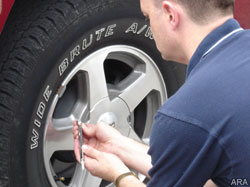(ARA) – Gas is pretty expensive so you certainly don’t want to waste it. But millions of U.S. drivers waste gas by the gallon every day by driving on under-inflated tires.
Fewer than 8 percent of vehicles have four properly inflated tires, according to a Rubber Manufacturers Association-sponsored national tire pressure survey. Worse, at least 20 percent of vehicles were found to have at least one tire under-inflated by at least 8 psi.
Driving on under-inflated tires can significantly affect fuel economy and safety. The U.S. Department of Energy says that properly inflated tires can improve fuel economy by 3.3 percent and help you save 9 cents per gallon at the pump. The National Highway Traffic Safety Association (NHTSA) estimates that under-inflated tires contribute to more than 600 fatalities and 33,000 injuries a year.
To help keep your car and tires road-worthy, make sure you check your tire pressure at least once a month and before every long trip (including the spare). Keep tire pressure at the level recommended by the vehicle manufacturer.
Under-inflation creates excessive stresses and heat and may lead to tire failure that could result in vehicle damage and serious injury or death.
Another problem to watch out for is tires and wheels that are out of balance or misaligned, which can cause uneven wear or vehicle problems. Have your alignment checked periodically and rotate tires every 5,000 to 8,000 miles to help get the most miles from your tires.
Be tire smart – play your “P.A.R.T.” That stands for pressure, alignment, rotation, and tread, which are the key elements of monthly tire maintenance.
* Pressure: Check tire pressure monthly before you drive with a tire gauge and inflate to vehicle manufacturer’s recommended pressure.
* Alignment: Misalignment of wheels can cause uneven and rapid tread wear.
* Rotation: Rotate every 5,000 to 8,000 miles to help you achieve more uniform wear.
* Tread: Bald tires are dangerous. Insert a penny, head first, into the tread groove. If you see all of Lincoln’s head, it’s time for a new tire.
For more information visit RMA’s website at www.betiresmart.org.
Courtesy of ARAcontent

